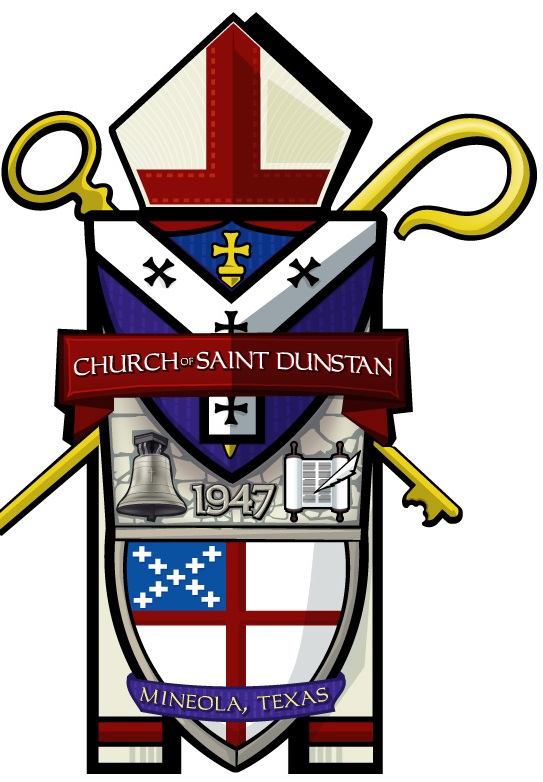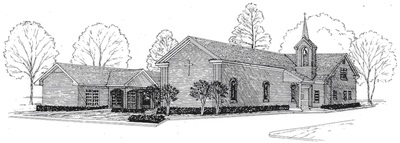St. Dunstan (circa 909-988), English prelate, statesman and reformer after whom this community of faith is named.
Dunstan, who was born near Glastonbury, England and educated by Irish clerics, became accomplished in the arts of metalworking, manuscript illumination, and music. After a life of service as monk, then Abbot of Glastonbury and ultimately Archbishop of Cantebury, he retired to Canterbury, where he spent the remainder of his life working for the spiritual and temporal improvement of the people, building and restoring churches, establishing schools, judging suits, defending the widow and the orphan, promoting peace, and enforcing respect for purity. He practiced his handicrafts of making bells and organs, and illuminating the books in the cathedral library. He encouraged and protected scholars from all lands who came to England, and was unwearied as a teacher of boys in the cathedral school. He died on May19, 988.
Dunstan is regarded as one of the great Anglo-Saxon saints, and has been called one of the makers of England. Dunstan is a patron saint of armorers, blacksmiths, goldsmiths, locksmiths and musicians.
HISTORY OF THE CHURCH OF ST. DUNSTAN IN MINEOLA
Almost 1000 years later, in the summer of 1947, the Rev. Henry Fullerton, accompanied by the Rev. T.P. Ball, Chaplain to the Bishop of Dallas, visited Mineola, Texas, seeking persons interested in organizing an Episcopal Mission in the community. The first meeting of the Episcopalians in Mineola was held during the second week of July, 1947. The first celebration of the Holy Eucharist was held on July 21,1947 with six present. Following the receipt of a letter of commitment containing twelve signatures, the small group became a Mission Church. The first Holy Baptism at Saint Dunstan's was on August 31, 1947. The first Confirmation was on October 13, 1947. Bishop C. Avery Mason confirmed and preached with twenty-seven in attendance.

Saint Dunstan's Episcopal Church broke ground for a Parish Hall at 800 N. Johnson St. in Mineola, on December 5, 1948. On Palm Sunday, April 10,1949, the first service was held in the newly constructed Parish Hall with 39 present. The first Church School was held on October 1, 1949, with sixteen students.
On April 27, 1952, the first service was held in the new church building. Adult Bible Study following Evening Prayer was begun in January 1955. Parish status was attained January 1, 1956.

The Rev. Henry Fullerton was the parish priest at Saint Dunstan's from its beginning until May 1963. The Rev. Henry Roberts became the parish priest in 1963 for approximately eight months. The Rev. Ralph Woods became the parish priest in September, 1964, and retired in 1983. The Rev. Michael Metcalf succeeded Fr. Woods, and remained with St. Dunstan's until 1986, when he accepted a call to a church in Dallas. Fr. Metcalf was the first priest at St. Dunstan's to be married with a family. The Rev. R. E. McCrary and his family came to St. Dunstan's in 1987, and remained until his death on January 23, 2001. During this time the construction of the new office wing and covered porch was completed and consecrated by Bishop Donis.

The Rev. Thomas A. Pantle succeeded Fr. McCray, and celebrated his first Holy Eucharist at St. Dunstan's on September 1, 2002. During the 16 years that Fr. Pantle served here, the church has grown both in membership and the physical plant. The Columbarium, Memorial Wall and Courtyard were begun in 2004 and completed a year later. He retired in 2018 to begin working with rural churches at the behest of the Diocese.
 During 2004 the need to increase the physical plant was discussed informally among the members. The discussion in 2006 led to the action of the Vestry to begin planning for physical expansion and a parking lot. The expansion of the physical plant was formally dedicated by Bishop James M. Stanton in an evening service.
During 2004 the need to increase the physical plant was discussed informally among the members. The discussion in 2006 led to the action of the Vestry to begin planning for physical expansion and a parking lot. The expansion of the physical plant was formally dedicated by Bishop James M. Stanton in an evening service.

Due to a bequeath in the will of Fr. Fullerton, the first rector of St. Dunstan, we were able to enlarge the Nave, rewire, relight, and repaint the Nave of the church, finish the standing seam metal roof over the old buildings. In addition, the old kitchen area was converted into a working sacristy and vesting sacristy for the clergy, lay readers, and acolytes. The fulfillment of the total plan was accomplished in October 2014 with the completion of the paved parking lot with designated markings.
In an announcement in the summer of 2019, the Bishop of the Diocese of Dallas, The Rt. Rev. Dr. George R. Sumner designated The Church of St. Dunstan as a pro-Cathedral and called St. Dunstan to a leadership role in East Texas under the direction of The Right Reverend Fraser W. Lawton, D.D., St. Dunstan's seventh Rector.
In sum, The Church of St. Dunstan is a small rural parish within the Diocese of Dallas. It had its beginning over 70 years ago in Mineola, TX and since has expanded to parishioners from 5 counties with frequent visitors from the Dallas metroplex and other areas. Two comments often heard from our visitors is the beauty and tranquility of our courtyard and the warm and caring feeling of our parishioners.